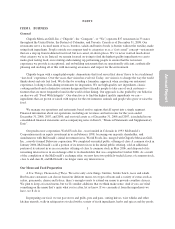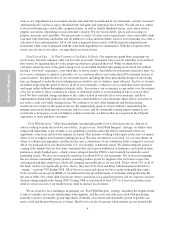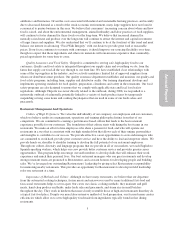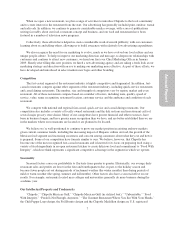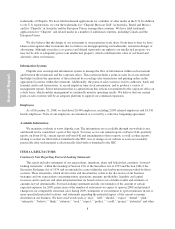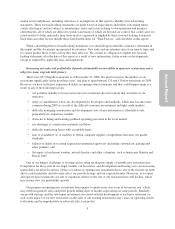Chipotle 2008 Annual Report Download - page 15
Download and view the complete annual report
Please find page 15 of the 2008 Chipotle annual report below. You can navigate through the pages in the report by either clicking on the pages listed below, or by using the keyword search tool below to find specific information within the annual report.
Developers may also delay or cancel projects in light of uncertainty in the commercial leasing market or
economic conditions generally. If developers do not proceed with projects in which we plan to locate restaurants,
our expansion plans may be hampered, which would adversely impact our growth and future profitability.
Our expansion into new markets may present increased risks due to our unfamiliarity with those areas.
Some of our new restaurants are planned for markets where we have little or no operating experience. For
instance we have announced plans to open a restaurant in London in 2009, which will be our first restaurant
outside of North America and our second outside the United States. New markets, particularly outside the United
States, may have different competitive conditions, consumer tastes and discretionary spending patterns than our
existing markets. As a result, new restaurants in those markets may be less successful than restaurants in our
existing markets. Consumers in a new market may not be familiar with the Chipotle brand, and we may need to
build brand awareness in that market through greater investments in advertising and promotional activity than we
originally planned. We may find it more difficult in new markets to hire, motivate and keep qualified employees
who can project our vision, passion and culture. Restaurants opened in new markets may also have lower average
restaurant sales than restaurants opened in existing markets, and may have higher construction, occupancy or
operating costs than restaurants in existing markets. We may also have difficulty finding reliable suppliers or
distributors or ones that can provide us, either initially or over time, with adequate supplies of ingredients
meeting our quality standards. Sales at restaurants opened in new markets may take longer to ramp up and reach
expected sales and profit levels, and may never do so, thereby affecting our overall profitability. Some or all of
these factors may be more pronounced in markets outside the United States due to cultural, regulatory or
economic differences with which we are not familiar, which may have a particularly adverse impact on our sales
or profitability in those markets and could thereby adversely impact our overall results.
We may not persuade customers of the benefits of paying our prices for higher-quality food.
Our success depends in large part on our ability to persuade customers that food made with higher-quality
ingredients is worth the prices they will pay at our restaurants relative to prices offered by some of our
competitors, particularly those in the quick-service segment. We may not successfully educate customers about
the quality of our food, and customers may not care even if they do understand our approach. That could require
us to change our pricing, advertising or promotional strategies, which could materially and adversely affect our
results or the brand identity that we have tried to create. Consumers may also be more price-sensitive during
difficult economic times, and we experienced some decrease in traffic during late 2008 that we attribute in part to
menu price increases. Many forecasts predict continued economic difficulties throughout 2009, so our ability to
increase sales may be significantly hampered for the foreseeable future.
Changes in customer tastes and preferences, spending patterns and demographic trends could cause sales
to decline.
Changes in customer preferences, general economic conditions, discretionary spending priorities,
demographic trends, traffic patterns and the type, number and location of competing restaurants affect the
restaurant industry. Our sales could be impacted by changes in consumer preferences in response to dietary
concerns, including preferences regarding items such as calories, sodium, carbohydrates or fat. These changes
could result in consumers avoiding our menu items in favor of other foods. Our success also depends to a
significant extent on consumer confidence, which is influenced by general economic conditions and discretionary
income levels. Negative consumer sentiment in the wake of the economic downturn has been widely reported in
2008 and early 2009. Our sales may decline during this or future economic downturns, which can be caused by
various factors such as high gasoline prices, or during periods of uncertainty, such as those that followed the
terrorist attacks on the United States in 2001. Any material decline in consumer confidence or a decline in family
“food away from home” spending could cause our sales, operating results, profits, business or financial condition
to decline. If we fail to adapt to changes in customer preferences and trends, we may lose customers and our sales
may deteriorate.
13
Annual Report


